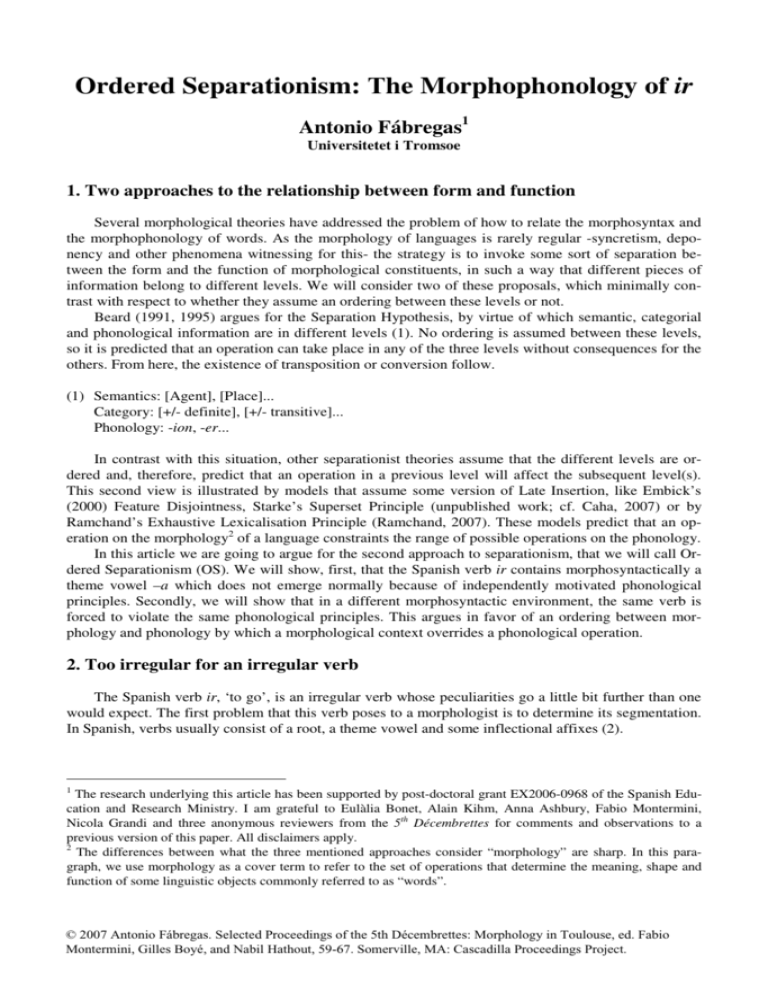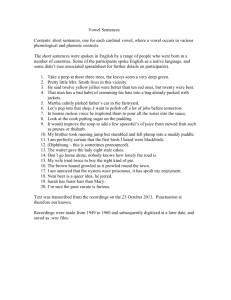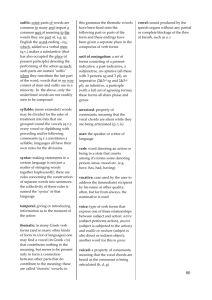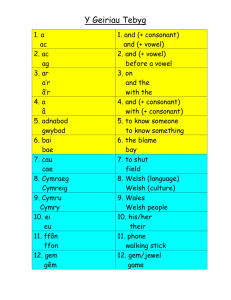
Ordered Separationism: The Morphophonology of ir
Antonio Fábregas1
Universitetet i Tromsoe
1. Two approaches to the relationship between form and function
Several morphological theories have addressed the problem of how to relate the morphosyntax and
the morphophonology of words. As the morphology of languages is rarely regular -syncretism, deponency and other phenomena witnessing for this- the strategy is to invoke some sort of separation between the form and the function of morphological constituents, in such a way that different pieces of
information belong to different levels. We will consider two of these proposals, which minimally contrast with respect to whether they assume an ordering between these levels or not.
Beard (1991, 1995) argues for the Separation Hypothesis, by virtue of which semantic, categorial
and phonological information are in different levels (1). No ordering is assumed between these levels,
so it is predicted that an operation can take place in any of the three levels without consequences for the
others. From here, the existence of transposition or conversion follow.
(1) Semantics: [Agent], [Place]...
Category: [+/- definite], [+/- transitive]...
Phonology: -ion, -er...
In contrast with this situation, other separationist theories assume that the different levels are ordered and, therefore, predict that an operation in a previous level will affect the subsequent level(s).
This second view is illustrated by models that assume some version of Late Insertion, like Embick’s
(2000) Feature Disjointness, Starke’s Superset Principle (unpublished work; cf. Caha, 2007) or by
Ramchand’s Exhaustive Lexicalisation Principle (Ramchand, 2007). These models predict that an operation on the morphology2 of a language constraints the range of possible operations on the phonology.
In this article we are going to argue for the second approach to separationism, that we will call Ordered Separationism (OS). We will show, first, that the Spanish verb ir contains morphosyntactically a
theme vowel –a which does not emerge normally because of independently motivated phonological
principles. Secondly, we will show that in a different morphosyntactic environment, the same verb is
forced to violate the same phonological principles. This argues in favor of an ordering between morphology and phonology by which a morphological context overrides a phonological operation.
2. Too irregular for an irregular verb
The Spanish verb ir, ‘to go’, is an irregular verb whose peculiarities go a little bit further than one
would expect. The first problem that this verb poses to a morphologist is to determine its segmentation.
In Spanish, verbs usually consist of a root, a theme vowel and some inflectional affixes (2).
1
The research underlying this article has been supported by post-doctoral grant EX2006-0968 of the Spanish Education and Research Ministry. I am grateful to Eulàlia Bonet, Alain Kihm, Anna Ashbury, Fabio Montermini,
Nicola Grandi and three anonymous reviewers from the 5th Décembrettes for comments and observations to a
previous version of this paper. All disclaimers apply.
2
The differences between what the three mentioned approaches consider “morphology” are sharp. In this paragraph, we use morphology as a cover term to refer to the set of operations that determine the meaning, shape and
function of some linguistic objects commonly referred to as “words”.
© 2007 Antonio Fábregas. Selected Proceedings of the 5th Décembrettes: Morphology in Toulouse, ed. Fabio
Montermini, Gilles Boyé, and Nabil Hathout, 59-67. Somerville, MA: Cascadilla Proceedings Project.
60
(2) a. root – theme vowel – inflectional morphemes
b. cant – a
–r
sing –1ST CONJ.
– INFINITIVE
‘to sing’
In principle, there are three options to analyze ir. The first one is to propose that the /i/ is the root
of the verb and there is no theme vowel (3a); the second one is to analyze /i/ as the theme vowel (3b),
and the third one is to propose that there are two /i/, one for the root and another for the theme vowel,
that are reduced phonologically to only one element (3c).
(3) Root
a.
b.
c.
i
∅
i
Theme vowel
∅
i
i
Inflection
r
r
r
We propose that the right segmentation is (3a), because, otherwise, the verb ir would stand alone
on the grammar of Spanish as the only case of an unattested irregularity, namely to take a set of affixes
which do not correspond to its paradigm.
2.1. What the imperfective morpheme wants to tell us
Spanish has three conjugations and only two allomorphs of the imperfective past morpheme. The
first conjugation, characterised by the theme vowel –a, always takes the allomorph –ba. Consider the
imperfective past tense of cantar, ‘to sing’ (4)
(4) Imperfective tense from the first conjugation
Root
cant
cant
cant
cant
cant
Theme vowel
a
a
a
a
a
Imperfective Tense
ba
ba
ba
ba
ba
Agreement
s
mos
is
n
∅
In contrast, verbs from the second and third conjugation (characterized by the theme vowels –e and
–i) both use a different allomorph, -a. Consider the verb partir, ‘to leave’, from the third conjugation,
and the verb comer, “to eat”, from the second. Notice that in both cases the theme vowel is –i.
(5) Imperfective tense forms from the second and third conjugation.3
Root
com / part
com / part
com / part
com / part
com / part
3
Theme vowel
i
i
i
i
i
Imperfective Tense
a
a
a
a
a
Agreement
s
mos
is
n
∅
A few words are in order to justify the morphological segmentation proposed here and in table four. Evidence to
analyse –ía as two separate morphemes comes from the fact that the affix -i identifies the verbal stem in other
forms of the paradigm, such as the imperfective subjunctive com-i-e-ra / part-i-e-ra or the participle com-i-do /
part-i-do, and in these forms the morpheme does not co-occur with -a. If we want to avoid postulating unnecessary
homophony in the paradigm, the presence in these forms of –i independently of –a leads to the conclusion that the
speaker does not analyse –ía as a unit, but as a sequence of the theme vowel plus a tense / aspect morpheme. The
same reasoning applies to the first conjugation in favour of analysing –aba as two affixes.
61
Now, the problem is that if we consider the verb ir as a member of the third or the second conjugations, it will be the only case of a verb of this class which takes the tense allomorph -ba, characteristic
of the first conjugation, in the imperfective.
(6) i-ba-s
i-ba-mos
i-ba-is
i-ba-n
i-ba-∅
This fact has been noticed by traditional grammarians of Spanish. In the Esbozo (2.12.8, p. 306),
written in 1973 by Samuel Gili Gaya and Salvador Fernández Ramírez, it is noted that the imperfect iba
is unique in Spanish due to the combination of affixes. In historical grammars, this anomaly is occasionally remarked; Menéndez Pidal (1968: § 117, d.) notes that the imperfect form of this verb is unexpected, because it exhibits inappropriate tense morphemes. As far as we know, in the history of Spanish, there has never been another imperfective form of the imperfective past tense of this verb.
The combination of affixes has puzzled traditional grammarians because the verb ir is assumed to
belong to the third conjugation, but it shows the imperfective morpheme which corresponds to the first
conjugation.
One possible answer would be to claim that this is only another of the verb’s irregularities. This
answer would be wrong, in our opinion, because that type of irregularity is unattested. A verb may be
irregular because the root changes formally in certain forms. For example, the verb contar, ‘to count’,
shows two forms, cuent- and cont-, depending partially on the position of the stress. With the exception
of contar and other verbs with the same irregularity, no unstressed /o/ becomes /ue/ in contemporary
Spanish.
(7) cuént-o
cuént-as
cuént-a
cont-ámos
cont-áis
cuént-an
A verb may also be irregular because the stem loses its theme vowel in some forms. For example,
the future of verbs such as poner, “to put”, or poder, “can” (8a and 8b) and the imperative of venir, “to
come”, or salir, “to go out” (8c and 8d) show this type of irregularity.
(8) a.
b.
c.
d.
poner Æ pond-ré, not *pon-e-ré
poder Æ pod-ré, not *pod-e-ré
venir Æ ven-∅, not *ven-e
salir Æ sal-∅, not *sal-e
A verb may be irregular also because it belongs to one conjugation in a form and to another one in
the other. For example, the verb andar, to walk, belongs to the first conjugation in its present forms, but
to the third one in the perfect forms anduv-, which take the theme vowel /i/ characteristic of these elements.
Finally, a verb may be irregular because the root or stem uses suppletive forms all along the paradigm. This is the case with the verb ser, ‘to be’, that has three different forms, s-, er- and fu-.
In our analysis, the verb ir is irregular in some of these senses. However, no irregular verb is irregular because it exhibits combinations of morphemes which are elsewhere unattested in the paradigms. That is, no isolated irregular verb picks a morpheme for second person to spell out a first person,
62
and no isolated irregular verb selects a future morpheme from its paradigm when it spells out the past
form, and so on. Then, claiming that in the verb ir, the allomorph -ba is picked instead of -a because the
verb is irregular would be stipulative and ad hoc.
Our proposal is that the verb ir is no exception to the class of morphemes selected by each conjugation. It belongs to the first conjugation, that which is identified by the theme vowel -a, and it takes,
regularly, the past tense morpheme -ba. The question, them, is how to prevent the phonological materialization of the theme vowel –a in Spanish only in this context.
3. How to stop a theme vowel
The vowel /a/ is phonologically very stable in Spanish. The rare cases of loss or change of /a/
which can be found in the historical morphology of Spanish can be related with an independent morphological process or with some case of non systematic phonological change –popular etymology
mainly, but not exclusively, as in rana-cuajo > renacuajo, ‘tadpole’–. We will propose that, also in the
case of ir, the reason for the non insertion of /a/ is more morphological than phonological, even though
there are phonological reasons to explain it.
We claim that the theme vowel is not inserted in order to avoid that the root changes. The requisite
that precludes the theme vowel from being inserted is morphological, not phonological, and is an instance of the cross-linguistically robust generalization that the preservation of the shape of roots outranks the preservation of the shape of affixes. This principle, named ROOT-FAITHFULNESS, has been
widely discussed in the phonological literature and has been shown to play a significant role in consonant inventories, accent placing or reduplication (McCarthy & Prince, 1995, Urbanczyk, 1996, Alderete, 2001). The proposal is that ROOT-FAITHFULNESS is ranked higher than AFFIX-FAITHFULNESS, in
such a way that when the phonological requisites of the affix clash with those of the root, it is the affix,
and not the root, that undergoes a process of repair. The prevalence of roots is grounded on their privileged role on lexical retrieval and recognition, as well as other psycholinguistic processes (Beckman,
1997).
(9) ROOT-FAITHFULNESS >> AFFIX-FAITHFULNESS
Let us see how this ranking explains the shape of the verb ir. The radical /i/ is obviously phonologically weak, with the consequence that its shape may be altered by phonological rules, therefore
making it less transparent.
It is a fact of the Spanish phonology that when a [+high] vowel is in the same syllable as another
vowel, it becomes a glide and forms a diphthong with it. We assume that in this phonological context,
the rule which forms diphthongs is unescapable – unless the two adjacent vowels are lexically specified
as belonging to different syllables. At the same time, in Spanish phonology it is clear that a glide in
onset position becomes a consonant. The derivations in (10) illustrate this process.
(10)
/iéro/ Æ [yéRo], hierro, ‘steel’
/iélo/ Æ [yélo], hielo, ‘ice’
/uérto/ Æ [gwéRto], huerto, ‘orchard’
The insertion of the theme vowel -a after the radical /i/ would create the same phonological context
as in (10), that is, a high vowel followed by a vowel in word-initial position. This contexts leads fatally
to the transformation of the root /i/ into /y/, as in (11).
(11)
/iába/ Æ [yáβa]
In Optimality Theory, the way in which this case can be analyzed is very interesting. There would
be three constraints at play. First of all, a constraint of ROOT-FAITHFULNESS which favors maximal
preservation of the phonological shape of the root. This constraint would be ranked very high in the
hierarchy. Secondly, one markedness constraint is able to give account of the transformation of the high
63
vowel into a consonant: ONSET. Finally, there would be a third constraint that favors the preservation of
the theme vowel; this last constraint belongs to the family of AFFIX-FAITHFULNESS constraints; we state
it as DEPENDENCY (THEME VOWEL). This constraint is dominated both by the root faithfulness family of
constraints and by the markedness constraint ONSET. (12) illustrates how the ranking ROOTFAITHFULNESS >> ONSET >> DEP (THEME VOWEL) accounts for the attested form iba as opposed to
*yaba (and other possible candidates).
(12)
ya.ba
ja.ba
i.a.ba
)i.ba
ROOT-FAITHFULNESS
*!
*!
ONSET
DEP(THV)
*
**!
*
*
In this account, the Theme Vowel is inserted and then the Phonology chooses not to spell it out; in
other words, the morphological position for the insertion of the Theme Vowel is present in the morphology (and arguably also in the syntax, Fábregas & Pazó (2006), but no phonological information
would emerge there. This situation is compatible, we believe, with a strictly interpretive view of phonology, where it is a non generative level, that interprets the information that comes from other levels,
in this case, morphology. The decision that phonology takes in this case is strongly conditioned by
morphological units, because at this point phonology must be sensitive to the different morphological
constituents, such as theme vowel, root and so forth.
The question now is under which circumstances the phonology can allow the non insertion of phonological material in a morphosyntactic terminal. Learnability issues suggest that this situation cannot
be always allowed, and indeed we know that ellipsis is strongly conditioned by the recoverability of the
non spelled out material. In general, what we have learnt from ellipsis studies is that a phonologically
non licensed morphosyntactic terminal has to be identified by an adjacent constituent which has phonological material. What counts as adjacency may differ from one level of the grammar to the other (Embick & Noyer, 2001), but it is reasonable to suppose that in the phonological level the relevant notion is
linear adjacency.
The other question that becomes relevant is what exactly counts as identification. This is a matter
on its own which has to be answered on empirical grounds for the general case. However, it is relatively
clear what means identifying in the case of a theme vowel: affixes belonging to the verbal paradigm can
license the ellipsis of the theme vowel, because they play the same role of category identification that
otherwise the theme vowel does in Spanish.
Taking into account these two components, we can state the principle that licenses Theme Vowel
ellipsis in the following way:
(13)
Erase from the phonological representation a Theme Vowel if it is linearly adjacent to a phonologically explicit affix that identifies the grammatical category of the word.
Notice that this principle states under which circumstances it is possible to erase a theme vowel
when there is a clash between the morphology and the phonology of the word. When there is no clash
between these two components (e.g., in evalu-a-ba, evaluate.IMPF), there is no need to erase a theme
vowel. Due to economy conditions, if there is no need to erase a constituent from the representation, the
constituent cannot be erased, because a representation that applies a rule of erasure is less economic
than one which doesn’t (cf. also Nunes, 2004 about deletion of features in non trivial chains).
In the second section, we will see how this principle forces the phonology to violate RootFaithfulness in the context of the gerund.4
4
As one of the reviewers notices, one relevant question here is why the form v- (v-oy, v-amos…) is not used in the
context of the imperfective form to construct the phonologically and morphologically unproblematic form v-a-ba.
The distribution of the three suppletive roots of the verb ir (i-, v- and fu-) widely exceeds the limits of this article,
64
3.1. Morphosyntax outranks morphophonology: the gerund
The form yendo is an unexpected form in our previous analysis. In this form the root /i/ is clearly
changed into an /y/, which is precisely the result that Root-Faithfulness avoided. We will show that the
gerund has a more complex morphosyntactic structure and, due to the principle in (13), the phonology
is forced to violate Root-Faithfulness.
Oltra (1999) proposes that in a language such as Catalan and Spanish theme vowels are associated
to any functional head. Thus, according to this author, in a conditional form, where structurally there
are three functional heads, little v, Mood and Tense, there are three theme vowels, in bold in (14).
(14)
[[[cant-a]v-r-í]Mood-∅-a]Tense
‘would.sing.3SG’
However, Fábregas & Pazó (2006) show that the status of what has traditionally been considered
the theme vowel in verbs is different from the additional morphemes that are placed under the rest of
functional projections in the verbal domain. The morphological tradition has singled out the verbal
theme vowel from the other increments that the affixes may take in the paradigm for good reasons, as
their syntactic and phonological behavior differ greatly from the one of what Oltra calls theme vowels
of higher functional heads. In other words, I agree with Oltra that functional heads such as Mood or
Tense can have an additional morpheme, but the theme vowel that marks verbs as belonging to a specific conjugation class is a morpheme on its own, which is in the syntactic structure. To avoid confusion, I will call the additional affixes added to higher functional heads “increments” while I will reserve
the term theme vowel to what has traditionally been called so.
With this caveat in mind, accepting the rest of Oltra’s analysis, note that if there is an additional
functional projection in the gerund, we expect that there is an additional theme vowel. There is independent evidence that the gerund contains an additional functional head – arguably of prepositional
nature –, and we will revise it in the following paragraphs.
3.1.1. Gerunds are more complex
Among the pieces of evidence for an additional head in the gerund, notice that gerunds may have
an illocutive interpretation in discourse initial position, that is, even when they cannot be interpreted as
part of a bigger sequence (15).
(15)
¡Anda-ndo!
walk-GERUND
‘Let’s go’
If we take syntax-semantics isomorphism seriously, there must be a head that conveys the propositional reading of the gerund, something impossible with other members of the paradigm. Consider for
example the infinitive; in Spanish, it can only take an illocutive reading equivalent to (15) in combination with a preposition.
(16)
*(A) calla-r
at shut.up-INFINITIVE
“Shut up”
as they raise many questions, among other things, with respect to the relationship between verbs belonging to
different paradigms (the root fu- is shared by the verb ir and the verb ser, “to be”). However, the distribution of vis relatively clear, as it can only be used in the present (both in indicative and subjunctive): voy / vaya. I propose
that this suppletive root is tagged as [present finite] in the lexicon, so it can only be inserted in finite contexts specified for present tense.
65
Secondly, gerunds have an adpositional function. Some gerunds are interpreted as locative expressions, equivalent to allí, ‘there’ (17), and also to PP’s introduced by en. Note that the copulative verb in
(17) is always the same, estar, which is generally used also with gerund durative periphrasis. Other
tests, like equative sentences, show that gerunds can express locations.
(17) a. La Real Academia está tomando la segunda calle a la izquierda.
the Real Academia is taking the second street to the left.
‘The Real Academia is located in a place to which one arrives turning left on the second street’
b. Tomando la segunda calle a la derecha es donde está la Real Academia.
taking the second street to the right is where is the Real Academia.
‘In a place to which one arrives turning right on the second street is where the Real Academia is’
Other gerunds have a temporal meaning, but most of them have a modal meaning equivalent to
several PP’s. Our proposal is that in the internal structure of the gerund there is a prepositional complementiser (Kayne 1994), that, being a functional head, defines a vocalic increment -e. (18) represents
this structure.
(18)
P
Pº
vP
vº
√
3.1.2. Consequences
Each of the functional heads introduces a position to insert a vowel. In the case of the gerund of the
verb ir, the gerund would contain two vowels, /a/ for little v, and /e/ for the Pº. The phonological materialisation of the verb ir would be the one in (19).
(19)
i
ROOT. go
a
THEME
VOWEL
∅-e
ndo
PREPOSITIONAL
COMPLEMENTISER
GERUND
Notice in the configuration that -a is the theme vowel of the verb, a morpheme on its own right,
while the form –e is an increment of a non-spelled out prepositional complementizer, added to the morphological representation in the way proposed by Oltra (1999).
To preserve ROOT-FAITHFULNESS, avoiding the sequence in which i- is followed by a non high
vowel, it would be necessary to erase both the verb’s theme vowel and the increment of the prepositional complementizer. The resulting form would be indo.
(20)
i
∅
∅-∅
ndo
But erasing both vowels at the same time goes against the principle that determines the licensing of
elliptic constituents. In the configuration in (20), the ellipsis of the theme vowel –a is not licensed by
any phonologically spelled out adjacent affix. This principle makes the form indo ungrammatical, in the
sense that it is not a possible input for the phonology to evaluate.
Thus, the only option is to allow one of the two theme vowels to surface. At this point, a principle
of faithfulness between different members of the paradigm (McCarthy, 2005) makes it a better option to
66
erase, as in the rest of the forms, the theme vowel –a than the prepositional complementizer increment
–e, resulting in the attested form yendo, whose structure is shown in (21).5
(21)
i
∅
∅-e
ndo
4. A short comparative note between Portuguese and Spanish
The historical origin of the puzzling properties of the verb ir come from the way in which Spanish
analised the Latin imperfect past from ire, which was already ibam, ibas, ibat, ibamus, ibatis and ibant,
following the general pattern in Latin, where first, second, third and fourth conjugations took systematically –ba for the imperfect tense: amabam from amare, tenebam, from tenere, faciebam, from facere,
and venibam, from venire.
Two neighboring Romance languages have reanalyzed this irregularity in different ways, trying to
assimilate it into the general pattern of the language. From one side, Spanish, as we have seen, analyses
the segment /i/ as the root, turning the verb into a first conjugation member, as we have argued.
The second possibility to solve the irregularity is to reanalyze the verb as a verb from the third conjugation, interpreting the /i/ as theme vowel, and provide it with an imperfective morpheme which is
standard in this conjugation. This is the solution taken by Portuguese:
(22)
ía
ías
ía
íamos
íeis
íam
This is the regular form of the imperfective past tense for the third conjugation in Portuguese. Let
us consider the verb partir, ‘to leave’.
(23)
partia
partias
partia
partiamos
partieis
partiam
From here it follows that there is no reason to propose that the verb ir in Portuguese does not belong to the third conjugation. In fact, the /i/ seems to be the theme vowel in this language.
(24)
Root
∅
∅
∅
∅
∅
5
Theme vowel
i
i
i
i
i
Past tense
a
a
e
a
a
Agreement
s
mos
is
m
∅
Our proposal makes it possible to explain other independent properties of the verb ir. The second person plural
imperative of any verb in Spanish loses the affix –d when an enclitic pronoun attaches to it: calla-d (shut up2PL.IMP) vs. calla-∅-os (shut up.IMP-you). This rule only knows one exception, the imperative of the verb ir, i-d,
where the affix –d can never disappear without leaving any trace: *i-∅-os (go.IMP-you). Under our analysis, the
explanation of this phenomenon is that the presence of –d is compulsory because it is licensing the ellipsis of the
theme vowel –a in a configuration [[[i-] -∅]TV –d]. If –d disappears, the configuration is ungrammatical.
67
5. Conclusions: a theory of morphophonology
In this article we have argued that Morphology determines the set of forms that Phonology can take
into account. Phonology chooses from a pre-determined set, which is constrained by forms which are
morphologically and syntactically grammatical. In other words, the morphological shape of a word,
determined by its morphosyntactic features, conditions in relevant senses the phonological materialization of the same word.
Going back to the question which motivated this discussion, the case of the verb ir, its lack of
theme vowel in some forms and the fact that in a morphologically more complex form like the gerund it
is forced to violate Root-Faithfulness, provides evidence that, even though different information may
appear in different levels, there is strict ordering relationship between these levels. A separationist theory should be able to giving account of cases where the syntax of a word forces the violation of a morphological principle, or the morphology forces that of a phonological principle. We believe that Late
Insertion hypotheses are this type of theory.
References
Alderete, John. 2001. Morphologically Governed Accent in Optimality Theory. New York / London: Routledge.
Beard, Robert. 1991. Decompositional composition: the semantics of scope ambiguities and bracketing paradoxes.
Natural Language and Linguistic Theory 9.2:195-229.
Beard, Robert. 1995. Lexeme-Morpheme Base Morphology. Albany: SUNY Albany Press.
Beckman, Jill. 1997. Positional Faithfulness. Doctoral Dissertation. UMass.
Bonet, Eulàlia, Maria-Rosa Lloret and Joan Mascaró. 2005. Lexical specifications and ordering of allomorphs: two
case studies. Ms. Universitat Autónoma de Barcelona & Universitat de Barcelona.
Caha, Pavel. 2007. The Superset Principle. Ms. Universitetet i Tromsoe.
Embick, David. 2000. Features, syntax and categories in the Latin perfect. Linguistic Inquiry 31.2:185-230.
Embick, David and Rolf Noyer. 2001. Movement operations after syntax. Linguistic Inquiry 32.4:555-598.
Fábregas, Antonio and José Pazó. 2006. Theme vowels in syntax. Ms. Universidad Autónoma de Madrid &
CASTL-Universitetet i Tromsoe.
Kayne. Richard. 1994. The Antisymmetry of Syntax. Cambridge: MIT Press.
Mascaró, Joan. 2005. External allomorphy and lexical representation. Ms. Universitat Autónoma de Barcelona.
Mascaró, Joan and Eulàlia Bonet. 2006. U u o e y o e. In A. Fábregas et alii, eds. XIII Cuadernos de Lingüística del
IUIOG. Madrid:Instituto Universitario Ortega y Gasset. 1-9.
McCarthy, John. 2005. Optimal paradigms. In L. Downing et alii, eds. Paradigms in Phonological Theory. Oxford:
Oxford University Press. 170-210.
McCarthy, John and Alan Prince. 1995. Faithfulness and reduplicative identity. In J. Beckman et alii, eds. UMass
Occassional Papers in Linguistics. Amherst: UMass. 249-384.
Menéndez Pidal, Ramón. 1968. Manual de gramática histórica española. Madrid: Espasa.
Nunes, Jairo.2004. Linearization of Chains and Sideward Movement. Cambridge (Mass.): MIT Press.
Oltra, Isabel. 1999. On the constituency structure of the Catalan verbs. In K. Arregi et alii, eds. Papers on Morphology and Syntax, Cycle One, MITWPL 33. 279-322.
RAE. 1973. Esbozo. Madrid: Espasa.
Ramchand, Gillian. 2007. Selection, Conflation and Denominal Verbs. Ms. Universitetet i Tromsoe.
Urbanczyk, Suzanne. 1996. Reduplication and Prosodic Morphology in Lushootseed. Doctoral Dissertation. Amherst. UMass.
Selected Proceedings of the 5th Décembrettes:
Morphology in Toulouse
edited by Fabio Montermini,
Gilles Boyé, and Nabil Hathout
Cascadilla Proceedings Project
Somerville, MA
2007
Copyright information
Selected Proceedings of the 5th Décembrettes: Morphology in Toulouse
© 2007 Cascadilla Proceedings Project, Somerville, MA. All rights reserved
ISBN 978-1-57473-421-8 library binding
A copyright notice for each paper is located at the bottom of the first page of the paper.
Reprints for course packs can be authorized by Cascadilla Proceedings Project.
Ordering information
Orders for the library binding edition are handled by Cascadilla Press.
To place an order, go to www.lingref.com or contact:
Cascadilla Press, P.O. Box 440355, Somerville, MA 02144, USA
phone: 1-617-776-2370, fax: 1-617-776-2271, e-mail: sales@cascadilla.com
Web access and citation information
This entire proceedings can also be viewed on the web at www.lingref.com. Each paper has a unique document #
which can be added to citations to facilitate access. The document # should not replace the full citation.
This paper can be cited as:
Fábregas, Antonio. 2007. Ordered Separationism: The Morphophonology of ir. In Selected Proceedings of the 5th
Décembrettes: Morphology in Toulouse, ed. Fabio Montermini, Gilles Boyé, and Nabil Hathout, 59-67.
Somerville, MA: Cascadilla Proceedings Project.
or:
Fábregas, Antonio. 2007. Ordered Separationism: The Morphophonology of ir. In Selected Proceedings of the 5th
Décembrettes: Morphology in Toulouse, ed. Fabio Montermini, Gilles Boyé, and Nabil Hathout, 59-67.
Somerville, MA: Cascadilla Proceedings Project. www.lingref.com, document #1615.









